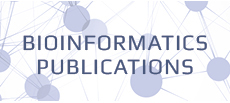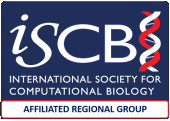Non-Coding RNAs: Computational Challenges and Applications
Organisers
Cenk Sahinalp, Lab for Computational Biology, Simon Fraser University, BC, Canada & Sabanci University, Istanbul, Turkey
Ugur Sezerman, Biological Sciences and Bioeng. Prog., Sabanci University , Istanbul Turkey
Ron Shamir, Computer Science Department, Tel Aviv University, Israel
Rolf Backofen, Institute of Computer Science, University of Freiburg, Germany
Introduction
Until recently RNA was thought to have only two functions: primarily as an information transmitter between DNA and proteins in the form of a messenger RNA (mRNA) and as a catalyser or an information decoder in protein synthesis in the form of a ribosomal RNA (rRNA) or a transfer RNA (tRNA). The discovery of RNA interference (RNAi), the post transcriptional silencing of gene expression via interactions between mRNAs and their regulatory RNAs has changed this simple picture. More recent studies have revealed that regulatory RNAs are only a very small subset of non-coding RNAs. A large fraction of the genome sequences give rise to RNA transcripts that do not code for proteins. The functionality many such non-coding RNAs are only scarcely known.
Much of the attention to non-coding RNAs have focused on small regulatory RNAs (srRNA). Recent computational estimates of the number of srRNAs in Arabidopsis thaliana is in the order of 1.5 million. Among srRNAs two subclasses form the bulk of all regulatory RNAs: microRNAs (miRNAs) and small interfering RNAs (siRNAs) - which are of similar length (21 to 25 nt) and composition but differ by origin. It is predicted that these two subclasses regulate at least one-third of all human genes. Yet there are many other classes of non-coding RNAs with functionalities beyond simple regulation of gene expression: examples include snoRNAs, snRNAs, gRNAs, and stRNAs, which respectively perform ribosomal RNA (rRNA) modification, RNA editing, mRNA splicing and developmental regulation.
The main objective of this meeting is to discuss new algorithms, software tools and their applications in non-coding RNA bioinformatics. In particular we aim to bring in some of the world's leading scientists who have made significant recent progress in (i) computationally identifying the loci of non-coding RNAs on a genome sequence, (ii) intelligently using novel sequencing technologies towards identifying all functional non-coding RNA sequences in an organism, (iii) predicting the exact form of interactions among non-coding RNAs, between non-coding RNAs and coding RNAs, non-coding RNAs and DNA as well as proteins and small molecules, and, as a result, (iv) understanding the exact functionality of non-coding RNAs, (v) non-coding RNA databases (e.g. Rfam) and algorithms for efficient search in such databases. Central to all these goals are the (v) computational methods to improve the accuracy of the existing tools for predicting the independent structure of an RNA sequence with or without pseudoknots. Once the functionality and the structure of known RNAs are well understood, one can hope to develop (vi) novel non-coding RNAs for specific purposes, for example for regulating the expression of targeted genes. In principle, these artificial regulatory RNA molecules could be employed as drugs for the treatment of a variety of human diseases such as several types of cancer, rheumatoid arthritis, brain diseases and viral infections.
Specific problems we will discuss in this meeting include applications of combinatorial algorithms and machine learning tools towards (1) learning thermodynamic parameters that are involved in the determination of secondary and tertiary structure of non-coding RNAs, (2) novel approaches to single or joint RNA structure determination, (3) algorithms for exploring RNA folding pathways and kinetic traps on the energy landscape, (4) algorithms for modelling interactions between RNAs and other molecules, (5) combinatorial and heuristic tools for de novo non-coding RNA identification on a genome sequence, (6) modelling classes of non-coding RNAs through stochastic context free grammars and their variations, (7) tools that detect structural motifs in a genome sequence, especially those that could be potentially involved in the regulation of target mRNAs, (8) computational challenges in the use of 454 pyrosequencing and the Solexa technologies for the identification of small and longer non-coding RNAs in an organism and (9) computational identification of their regulatory, catalytic and structural roles in the cell, (10) alignment of multiple non-coding RNA sequences and (11) efficient algorithms for searching RNAs in a data collection with specific sequence and structural motifs.
We hope that the meeting will not only bring in some of the world's leading experts and provide a comprehensive coverage of the leading computational tools related to non-coding RNA bioinformatics but also set up a forum for discussing some of the existing and future challenges related to non-coding RNA algorithms and their applications and emerging technologies and related computational tools that can help to address these challenges.
Draft Programme
Monday 28th April
Session 1: RNA structure prediction, physical and computational determination of RNA folding parameters; 09:00-12:00
Session 2: Modelling folding pathways, kinetic traps, interactions between RNAs and other molecules. 14:30-17:30
Oral Presentations 17:30-18:00
Round table discussion 18:00-18:30 .
Tuesday 29th April
Session 3: Methods for non-coding RNA identification, de novo algorithms, aligning RNA sequences, stochastic context free grammars for non-coding RNA families; 09:00-12:00
Session 4: The use of novel sequencing technologies in the determination and functional identification of non-coding RNAs. 14:30-17:30
Oral Presentations 17:30-18:00
Round table discussion 18:00-18:30 .
Tuesday 29th April
Session 5: .Non-coding RNA databases and problems related to search, motif identification, target identification, automatic annotation; design of novel non-coding RNAs for regulatory, catalytic and structural functions; 09:00-12:00
Round Table discussion and Closing remarks 12:00-12:30.
Venue
The location of the workshop will be in Kemer, Antalya at Limra Hotel. Kemer is a town lying at the foot of Taurus mountains on the turquoise coast. The hotel where the meeting will be held is surrounded by pine forests, orange groves and historical sites. There are several low cost carriers such as German wings, Easy Jet, Air Berlin, Sky Air and Correndon airlines providing cheap flights to the city regularly. Antalya is also easily accessible via Turkish Airlines and other low cost local carriers in Turkey.
Registration
Registration is not open yet.
Speakers
The list of speakers will be available soon.
Cenk Sahinalp, Lab for Computational Biology, Simon Fraser University, BC, Canada & Sabanci University, Istanbul, Turkey
Ugur Sezerman, Biological Sciences and Bioeng. Prog., Sabanci University , Istanbul Turkey
Ron Shamir, Computer Science Department, Tel Aviv University, Israel
Rolf Backofen, Institute of Computer Science, University of Freiburg, Germany
Introduction
Until recently RNA was thought to have only two functions: primarily as an information transmitter between DNA and proteins in the form of a messenger RNA (mRNA) and as a catalyser or an information decoder in protein synthesis in the form of a ribosomal RNA (rRNA) or a transfer RNA (tRNA). The discovery of RNA interference (RNAi), the post transcriptional silencing of gene expression via interactions between mRNAs and their regulatory RNAs has changed this simple picture. More recent studies have revealed that regulatory RNAs are only a very small subset of non-coding RNAs. A large fraction of the genome sequences give rise to RNA transcripts that do not code for proteins. The functionality many such non-coding RNAs are only scarcely known.
Much of the attention to non-coding RNAs have focused on small regulatory RNAs (srRNA). Recent computational estimates of the number of srRNAs in Arabidopsis thaliana is in the order of 1.5 million. Among srRNAs two subclasses form the bulk of all regulatory RNAs: microRNAs (miRNAs) and small interfering RNAs (siRNAs) - which are of similar length (21 to 25 nt) and composition but differ by origin. It is predicted that these two subclasses regulate at least one-third of all human genes. Yet there are many other classes of non-coding RNAs with functionalities beyond simple regulation of gene expression: examples include snoRNAs, snRNAs, gRNAs, and stRNAs, which respectively perform ribosomal RNA (rRNA) modification, RNA editing, mRNA splicing and developmental regulation.
The main objective of this meeting is to discuss new algorithms, software tools and their applications in non-coding RNA bioinformatics. In particular we aim to bring in some of the world's leading scientists who have made significant recent progress in (i) computationally identifying the loci of non-coding RNAs on a genome sequence, (ii) intelligently using novel sequencing technologies towards identifying all functional non-coding RNA sequences in an organism, (iii) predicting the exact form of interactions among non-coding RNAs, between non-coding RNAs and coding RNAs, non-coding RNAs and DNA as well as proteins and small molecules, and, as a result, (iv) understanding the exact functionality of non-coding RNAs, (v) non-coding RNA databases (e.g. Rfam) and algorithms for efficient search in such databases. Central to all these goals are the (v) computational methods to improve the accuracy of the existing tools for predicting the independent structure of an RNA sequence with or without pseudoknots. Once the functionality and the structure of known RNAs are well understood, one can hope to develop (vi) novel non-coding RNAs for specific purposes, for example for regulating the expression of targeted genes. In principle, these artificial regulatory RNA molecules could be employed as drugs for the treatment of a variety of human diseases such as several types of cancer, rheumatoid arthritis, brain diseases and viral infections.
Specific problems we will discuss in this meeting include applications of combinatorial algorithms and machine learning tools towards (1) learning thermodynamic parameters that are involved in the determination of secondary and tertiary structure of non-coding RNAs, (2) novel approaches to single or joint RNA structure determination, (3) algorithms for exploring RNA folding pathways and kinetic traps on the energy landscape, (4) algorithms for modelling interactions between RNAs and other molecules, (5) combinatorial and heuristic tools for de novo non-coding RNA identification on a genome sequence, (6) modelling classes of non-coding RNAs through stochastic context free grammars and their variations, (7) tools that detect structural motifs in a genome sequence, especially those that could be potentially involved in the regulation of target mRNAs, (8) computational challenges in the use of 454 pyrosequencing and the Solexa technologies for the identification of small and longer non-coding RNAs in an organism and (9) computational identification of their regulatory, catalytic and structural roles in the cell, (10) alignment of multiple non-coding RNA sequences and (11) efficient algorithms for searching RNAs in a data collection with specific sequence and structural motifs.
We hope that the meeting will not only bring in some of the world's leading experts and provide a comprehensive coverage of the leading computational tools related to non-coding RNA bioinformatics but also set up a forum for discussing some of the existing and future challenges related to non-coding RNA algorithms and their applications and emerging technologies and related computational tools that can help to address these challenges.
Draft Programme
Monday 28th April
Session 1: RNA structure prediction, physical and computational determination of RNA folding parameters; 09:00-12:00
Session 2: Modelling folding pathways, kinetic traps, interactions between RNAs and other molecules. 14:30-17:30
Oral Presentations 17:30-18:00
Round table discussion 18:00-18:30 .
Tuesday 29th April
Session 3: Methods for non-coding RNA identification, de novo algorithms, aligning RNA sequences, stochastic context free grammars for non-coding RNA families; 09:00-12:00
Session 4: The use of novel sequencing technologies in the determination and functional identification of non-coding RNAs. 14:30-17:30
Oral Presentations 17:30-18:00
Round table discussion 18:00-18:30 .
Tuesday 29th April
Session 5: .Non-coding RNA databases and problems related to search, motif identification, target identification, automatic annotation; design of novel non-coding RNAs for regulatory, catalytic and structural functions; 09:00-12:00
Round Table discussion and Closing remarks 12:00-12:30.
Venue
The location of the workshop will be in Kemer, Antalya at Limra Hotel. Kemer is a town lying at the foot of Taurus mountains on the turquoise coast. The hotel where the meeting will be held is surrounded by pine forests, orange groves and historical sites. There are several low cost carriers such as German wings, Easy Jet, Air Berlin, Sky Air and Correndon airlines providing cheap flights to the city regularly. Antalya is also easily accessible via Turkish Airlines and other low cost local carriers in Turkey.
Registration
Registration is not open yet.
Speakers
The list of speakers will be available soon.




